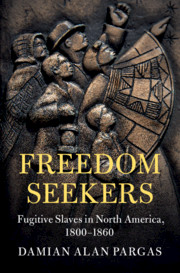Book contents
- Freedom Seekers
- Cambridge Studies on the American South
- Freedom Seekers
- Copyright page
- Contents
- Figures
- Acknowledgments
- Introduction
- 1 The Changing Geography of Slavery and Freedom
- 2 “Lurking amongst the Free Negroes”
- 3 “As If Their Own Liberty Were at Stake”
- 4 “Departure from the House of Bondage”
- Conclusion
- Bibliography
- Index
Introduction
Published online by Cambridge University Press: 19 November 2021
- Freedom Seekers
- Cambridge Studies on the American South
- Freedom Seekers
- Copyright page
- Contents
- Figures
- Acknowledgments
- Introduction
- 1 The Changing Geography of Slavery and Freedom
- 2 “Lurking amongst the Free Negroes”
- 3 “As If Their Own Liberty Were at Stake”
- 4 “Departure from the House of Bondage”
- Conclusion
- Bibliography
- Index
Summary
How was slave flight in North America characterized? How and why did enslaved people flee to—and navigate—different destinations throughout the continent, and to what extent did they succeed in evading recapture and reenslavement? The Introduction lays out overarching questions and purpose. Freedom Seekers examines the experiences of runaways from southern slavery between 1800 and 1860. Taking a continental approach, this study highlights the diversity of slave flight in North America by conceptually dividing the continent into three distinct (and continuously evolving) spaces of freedom for runaway slaves, namely: spaces of informal freedom in the US South, where enslaved people attempted to flee slavery by trying to pass for free; spaces of semi-formal freedom in the Northern United States, where slavery was abolished but where the status of fugitive slaves was contested; and spaces of formal freedom in Canada and Mexico, where slavery was abolished where runaways were considered legally free and safe from reenslavement. The Introduction to this study also positions it within the scholarship on fugitive slaves, explaining its innovative continental perspective and new conceptual approach.
Keywords
- Type
- Chapter
- Information
- Freedom SeekersFugitive Slaves in North America, 1800–1860, pp. 1 - 14Publisher: Cambridge University PressPrint publication year: 2021



